{Click on an image to enlarge, then use the back button to return to this page}
This page last updated on 05/22/2017
 |
| (Fig. 01) |
|
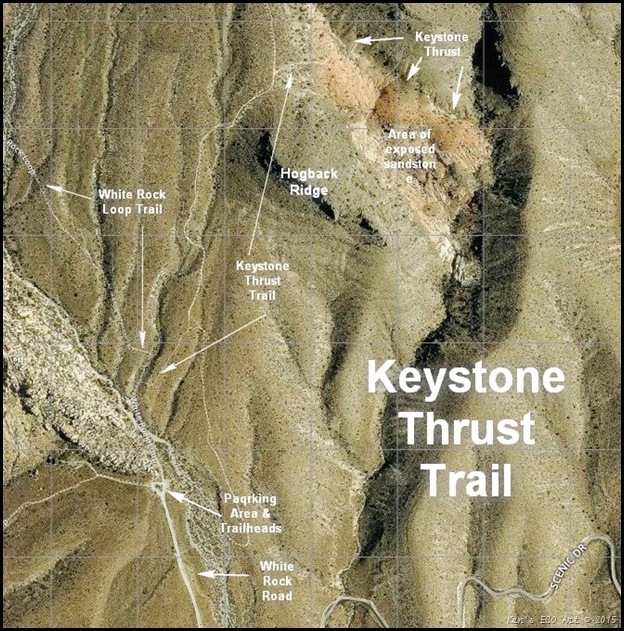 |
| (Fig. 02) |
|
Directions: From the Stratosphere Casino take a right onto Las Vegas Blvd south (the Strip) to Sahara Ave. Turn right onto West Sahara Ave (NV-589) and continue to follow W. Sahara Ave to 10 miles until it turns into Desert Foothills Drive. Continue on for about 4.5 miles and turn left onto NV-159 (W. Charleston Blvd). Continue to follow NV-159 (which becomes Blue Diamond Road) west for about 4.5 miles and turn right onto Red Rock Canyon Rd. After entering Red Rock Canyon, take the paved, one-way, Scenic Drive Road and drive approximately 5.5 miles to the White Rock Road (Fig. 02). This rocky dirt road leads north another mile to a fenced parking area that serves as the trailhead for the White Rock and Keystone Thrust trails. Distance from Point of Origin: 22.5 miles. Estimated (one Way) travel time: 45 minutes.
|
11/10/2015 Trip Notes: Blake Smith and I almost didn’t attempt this hike based upon the weather predictions. In fact by the time we got to Red Rock Canyon NCA it was extremely black and raining. However within a half an hour of arriving at the visitor center the rain stopped and the clouds started to clear over the mountains. As we prepared to leave the visitor center, headed out to White Rock Road and the trailheads, we were presented with some following vistas. (Fig. 01) is towards the Wilson Cliffs, (Fig. 03) is towards the Calico Hills, Turtle Peak and the La Madre Mountains, and the White Rock Hills in (Fig. 04). (con’t below)
|
 |
| (Fig. 03) |
|
 |
| (Fig. 04) |
|
From the parking area the trail heads north, crossing a large wash (Fig. 05). A hundred yards beyong the wash the Keystone Thrust trail veers to the right and up a hill that is stepped with nearly a dozen “steps” made with some old railroad ties (Fig. 06). Joining with an old jeep trail, from here the trail climbs about 500 feet up the ensuing hill along side Hogback Ridge (Fig. 02) to the high point of the trail. We even passed a few patches of snow (Fig. 07). Once you’ve passed Hogback Ridge you’ll come to another sign directing you toward the Keystone Thrust. This is the highest point of the trail and the views are really nice with Turtlehead Peak and the Calicos to the east (Fig. 08), the La Madre Mountains to the north (Fig. 09). At the saddle turn right and head down into a small canyon with a red sandstone floor. As we climbed down, you actually end up standing on the Keystone Thrust fault (Fig.10), though we thought it would actually expecting something that would be more definitive. Refer to the section below for a more detailed description of the Keystone Fault. Just this side of the actual fault line, we found a “quasi” shelter area that some hikers built (Fig. 11). Inside this walled area there made three stone “seats” on the inside of the walls (Figs. 12 & 13).
Following the trail along the upper edge of the fault line to the end of the colored sandstone area, go you end up at the top of what is probably a 100 foot waterfall (Fig. 14) when there are heavy rains, that falls down into a deep canyon that runs through dense shrubs and colorful boulders until the canyon slowly gives way to the open desert. The wash eventually leads back to the scenic loop drive, depositing you about a mile east of the White Rock turnoff. In stead of exiting this way, we decided to hike the trail back the same way we had come. In spite of the early rain, it turned out to be a beautiful day and really enjoyed the views everywhere we looked.
|
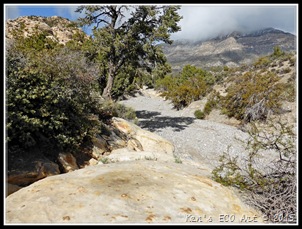 |
| (Fig. 05) |
|
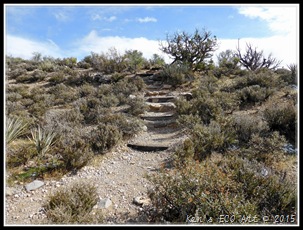 |
| (Fig. 06) |
|
|
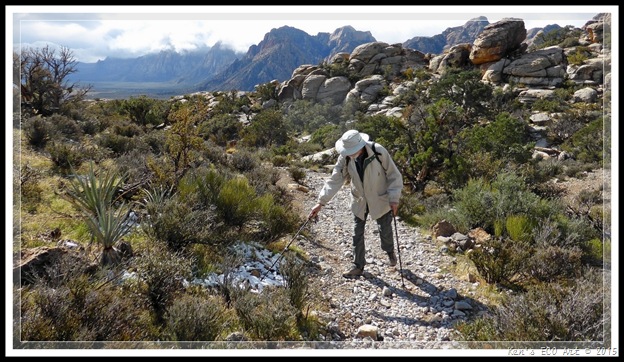 |
| (Fig. 07) |
|
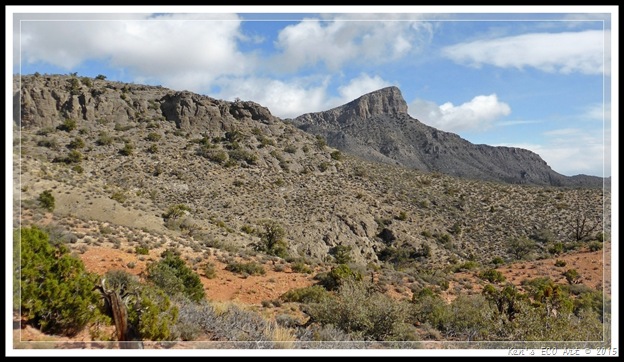 |
| (Fig. 08) |
|
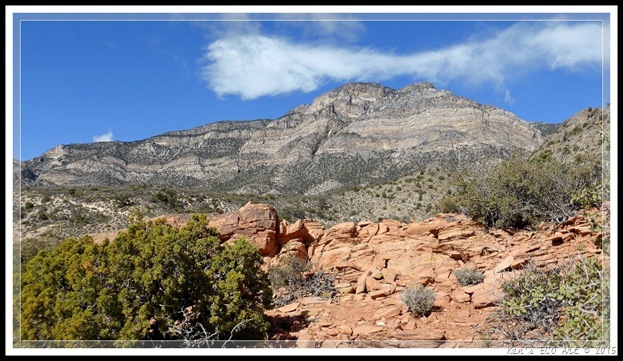 |
| (Fig. 09) |
|
 |
| (Fig. 10) |
|
 |
| (Fig. 11) |
|
 |
| (Fig. 12) |
|
 |
| (Fig. 13) |
|
|
 |
| (Fig. 14) |
|
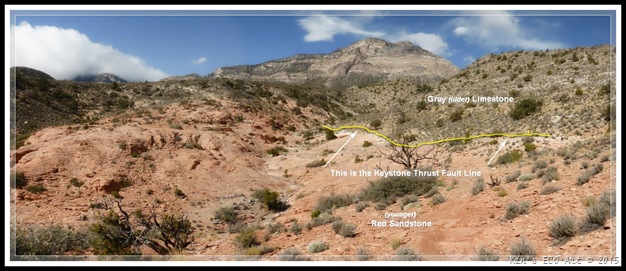 |
| (Fig. 15) |
|
Keystone Thrust Fault Description: The Keystone Thrust Fault (Fig. 15) is considered the most significant geological feature in Red Rock Canyon. For most of the last 600 million or so years, the Red Rock area was part of a deep ocean basin. About 225 million years ago, movements of the earths crust caused this sea-bed to rise slowly. By around 180 million years ago, this area had completely changed once more. By then, it had become part of a large desert with shifting red sands and huge dune fields. These sand dunes left their marks in the rocks and cliffs. About 65 million years ago, near the end of the Mesozoic Era, the oceanic plate (west) began colliding with the North American Plate (east) as the continent shifted. The crust was compressed causing an oblique fault. A “thrust fault” is a break in the Earth's crust from squeezing or compression; the block of crust on one side of the fault block moving up the fault plane and overtopping the block on the other side of the fault. At the time the thrust fault occurred, known as the Keystone Thrust, the crust here consisted of 180 million year old red and tan sandstone overtopping 500 million year old limestone and dolomite. A block of sandstone and underlying limestone was thrust on top of a similar block, causing an alternating mountain of sandstone on limestone on sandstone on limestone. Over the next several million years, the upper sandstone was exposed to the elements and eroded away, leaving older limestone (500 million years old) atop younger sandstone (180 million years old), the Keystone Thrust. When some of the sea-bed sediments were exposed to the atmosphere, they began to oxidize. The resulting varied exposed sandstone rock formations range from white, grey, tan, orange, and red. Here the 500 million year old limestone rests on 180 million year old sandstone, forming Turtlehead Peak, and the surrounding hills. The Keystone Thrust Fault extends from the Cottonwood Fault along State Route 160 north for 13 miles along the crest of the Red Rock escarpment. It then curves east along the base of La Madre Mountain before it is obscured by very complex faulting north of the Calico Hills. Red Rock Canyon NCA provides examples of one of the most dramatic and easily identified thrust faults to be found anywhere.
Return to previous page ... Red Rock Canyon National Conservation Area - Summary Page. |
|















